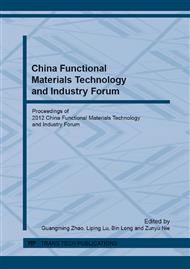[1]
Kawakami M, Terada O, Hayashi K (2006) J Jpn Soc Powder Powder Metall 53:166
Google Scholar
[2]
Schubert WD, Lassner E. Tungsten — still very much an element of lighting. The light bulb in the focus of global warming. Brussels: ITIA Newslette r; June 2007.p.2 –10.
Google Scholar
[3]
Tjong S.C. and ChenH., Nanocrystalline materials and coatings, Mater. Sci. Eng R, 2004, 45: 1.
Google Scholar
[4]
Bonache V, Ray n E, Salvador M D, et al. Nanoindentation study of WC-12%Co hardmetals obtained from nanocrystalline powders: Evaluation of hardness and modulus on individual phases [J]. Materials Science and Engineering A, 2010, 1: 2935-2941.
DOI: 10.1016/j.msea.2010.01.026
Google Scholar
[5]
Morton C.W., Wills D.J., and Stjernberg K., The temperature ranges for maximum effectiveness of grain growth inhibitors in WC-Co alloys, Int. J. Refract. Met. Hard Mater., 2007, 23: 287.
DOI: 10.1016/j.ijrmhm.2005.05.011
Google Scholar
[6]
H.J. Park, Y.K. Park, I.J. Dong, J.K. Jeon, J.H. Yim, K.E. Jeong, Res. Chem. Intermed. 34(8–9), 727–735 (2008)
DOI: 10.1007/bf03036931
Google Scholar
[7]
PETERSSON A, AGREN J. Sintering shrinkage of WC-Co materials with bimodal grain size distribution [J]. Acta Mat, 2005, 53(6): 1665í1671.
DOI: 10.1016/j.actamat.2004.12.016
Google Scholar
[8]
MORTON C W, WILLS D J, STJERNBERG K. The temperature ranges of maximum effectiveness of grain growth inhibitors in WC alloys [J]. Int J Ref Met Mat, 2005, 23(4-6): 287-293.).
DOI: 10.1016/j.ijrmhm.2005.05.011
Google Scholar
[9]
Kawakami M, Teranda O, Hayashi K. Segregation amount of dopants at WC/Co interface in Cr3C2 and VC+Cr3C2-doped WC–Co submicro-grained hardmetals. In: Kneringer G, Rodhammer P,Wildner H, editors. Proceedings of the 16th International Plansee Seminar, vol. 2. Reutte: Plansee Holding AG; 2005. p.653–67.
DOI: 10.2497/jjspm.53.166
Google Scholar
[10]
S.G. Huang R.L. Liu, L. Li,O.Van derBiest,NbC as grain growth inhibitor and carbide inWC–Co hardmetals, Int. J. Refract. Met. Hard Mater., 2007 in press.)
Google Scholar
[11]
Carroll D.F., Sintering and microstructural development in WC/Co-based alloys made with superfine WC powder, Int. J. Refract. Met. Hard Mater., 1999, 17: 123.
DOI: 10.1016/s0263-4368(98)00073-0
Google Scholar
[12]
Gille G, Szesny B, Dreyer K, van den Berg H, Schmidt J,Gestrich T, Leitner G (2002) Int J Ref Met Hard Mater 20:3
DOI: 10.1016/s0263-4368(01)00066-x
Google Scholar
[13]
Da Silva A.G.P., De Souza C.P., Gomes U.U., Medeiros F.F.P., Ciaravino C., and Roubin M., A low temperature synthesized NbC as grain growth inhibitor for WC-Co composites, Mater. Sci. Eng. A, 2000, 30: 242.
DOI: 10.1016/s0921-5093(00)00993-x
Google Scholar
[14]
Brieseck M, Bohn M, Lengauer W (2010) J Alloys Compounds 489:408
Google Scholar
[15]
Lay S, Hamar-Thibault S, Lackner A (2002) Int J Ref Met Hard Mater 20:61
Google Scholar
[16]
Shatov A V, Ponomarev S S, Firstov S A, et al. The contiguity of carbide crystals of different shapes in cemented carbides [J]. International Journal of Refractory Metals Hard Materials, 2006, 24(1-2):61.
DOI: 10.1016/j.ijrmhm.2005.03.003
Google Scholar
[17]
Lay S, Hamar-Thibault S, Lackner A. Location of VC in VC, Cr3C2 codoped WC–Co cermets by HREM and EELS. Int J Refract Met Hard Mat 2002;20:61–9.
DOI: 10.1016/s0263-4368(01)00071-3
Google Scholar
[18]
Weidow J, Zackrisson J, Jansson B, Andrén H-O. Characterization of WC–Co with cubic carbide additions. Int J Refract Met Hard Mater 2009;27:244–8.
DOI: 10.1016/j.ijrmhm.2008.11.007
Google Scholar
[19]
Sun L., Jia C.C., Lin C.G.., and Cao R.J., VC addition prepared ultrafine WC-11Co composites by spark plasma sintering, J. Iron Steel, 2007, 14: 85.
DOI: 10.1016/s1006-706x(08)60057-6
Google Scholar
[20]
Eso Oladapo, Fang Zhigang Zak, Griffo Anthony. Kinetics of cobalt gradient formation during the liquid phase sintering of functionally graded WC–Co. Int J Refract Met H 2007;25:286–92
DOI: 10.1016/j.ijrmhm.2006.07.002
Google Scholar
[21]
Fan Peng, Eso Oladapo O, Fang Zhigang Zak, Sohn HY. Effect of WC particle size on Co distribution in liquid-phase-sintered functionally graded WC–Co composite. Int J Refract Met H 2008;26:98–105.
DOI: 10.1016/j.ijrmhm.2007.02.003
Google Scholar


